Summary: Tong Deng, Jinse Finance
There are several specific factors that have led to the latest decline in cryptocurrency prices, including:
The US stock market has been unable to shake off the recent slump, and the impact of Deepseek is still fermenting.
The cryptocurrency market is still recovering from the $140 million Bybit exchange hack.
Investors are in risk-averse mode as cryptocurrency investment products continue to see outflows.
Strong upward resistance has dampened efforts to recover the global cryptocurrency market capitalization.
US stocks weigh on the crypto market
After a sharp decline last week, the major US stock indices failed to rebound on Monday afternoon, with the Nasdaq Composite closing down 1.2% and the S&P 500 down 0.5%.
On February 21, local time, Trump signed the "America First Investment Policy" memorandum. In terms of US outbound investment, the memorandum seeks to strengthen the review of US investment in China. As a result, US-listed Chinese stocks plummeted. The Nasdaq China Dragon Index extended its decline to 5.24%, and the Wind China Concept Technology Leaders Index fell more than 6%. Popular US-listed Chinese stocks across the board saw steep declines, with Alibaba and Bilibili falling more than 9%, and JD.com and Tencent Holdings falling more than 7%.
Additionally, the impact of Deepseek on the AI market is still ongoing. According to a report by investment bank TD Cowen, Microsoft has begun to cancel large-scale data center capacity leases in the US, potentially not renewing them, totaling several hundred MW, which may reflect Microsoft's doubts about its own excessive AI computing capacity. After Deepseek launched an open-source AI model claiming to be able to match US technology at extremely low cost, investors have expressed doubts about the continued massive spending of tech giants like Microsoft.
Furthermore, Nvidia's earnings report is raising concerns. On Wednesday, Nvidia will release its fourth-quarter earnings report. MarketWatch pointed out last week that this earnings report will provide more details on its new Blackwell chip architecture. Production has accelerated, but these products are facing shortages, delays, and overheating issues, which are said to have prompted some major customers to delay orders. These issues have raised concerns about Nvidia's short-term financial condition. These concerns arise as investors assess the potential for growth slowdown at companies and other large tech firms deeply invested in AI - typically those that have invested billions of dollars and purchased large quantities of Nvidia chips to bet on artificial intelligence. Bank of America Securities analyst in a report this month said Nvidia's earnings will be the "next major test of the AI bull market," and added that Nvidia's earnings per share "will still be substantial enough, even without much fanfare."
Regarding the US economy, Neil Dutta, head of economic research at Renaissance Macro Research, said the risks to the labor market are increasing. Real income growth is slowing, the housing market is deteriorating, and state and local governments are cutting spending. Worryingly, the market generally believes the economy will not slow down, with the median GDP forecast around 2.5%.
Dutta wrote: "If 2023 is an upside surprise, then 2025 is more likely to be a downside surprise."
"Passive monetary policy tightening is the main risk, which has important implications for financial market investors," Dutta continued. "I expect long-term interest rates to fall and stock prices to decline as risk appetite weakens. In terms of the economy, the job market situation is expected to deteriorate."
Ethereum leads the market plunge
Today's cryptocurrency market decline is part of the adjustment that began on February 21, when the Bybit cryptocurrency exchange was hacked, losing over $140 million worth of ETH and ETH-related tokens, the largest cryptocurrency theft ever.
On February 25, the sell-off continued, including:
Ethereum leading the market decline, down 11.5% in the past 24 hours, trading at $2,503.26.
Bitcoin and Solana also saw declines, with Bitcoin down 4.9% at $41,549.81 and Solana down 15.7% at $141.76.
Other cryptocurrencies such as XRP fell 10.8%; Dogecoin fell 13.7%; BNB fell 6.5%.
The large liquidations in the derivatives market have exacerbated the problem.
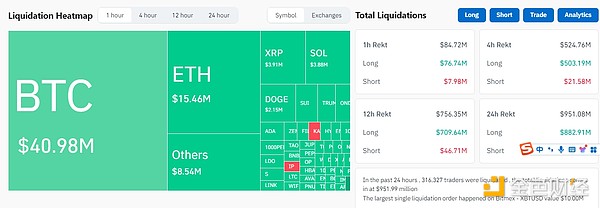
The sell-off triggered the liquidation of leveraged long positions, with 316,393 traders liquidated in the past 24 hours, totaling $952.08 million.
The dominance of long liquidations indicates that the cryptocurrency market was over-leveraged on the bullish side.
Although the current market sentiment is bearish, the cryptocurrency options trading platform QCP Capital stated that the reaction of cryptocurrency prices and implied volatility has been more moderate compared to the 2022 FTX collapse.
QCP Capital said in a Telegram message that this "highlights the increasing maturity of the cryptocurrency landscape," and added:
"Bybit's ability to quickly secure a bridge loan to plug the liquidity gap in a critical period highlights the resilience and ample liquidity in the lending space. Since 2022, the industry has been steadily recovering and experienced a significant surge before the last US presidential election."
Investors continue to avoid cryptocurrency risks
The ongoing adjustment in the cryptocurrency market is consistent with the capital outflows from cryptocurrency investment products.
Key points:
Digital asset investment products have seen outflows for the second consecutive week;
According to a report by CoinShares, the total outflow for the week ending February 21 was $508 million.
This indicates that institutional investors have reduced their investments in digital assets.
Bitcoin saw the largest outflows, totaling $571 million.
The year-to-date inflow has declined from $7.4 billion two weeks ago to $6.6 billion last week.
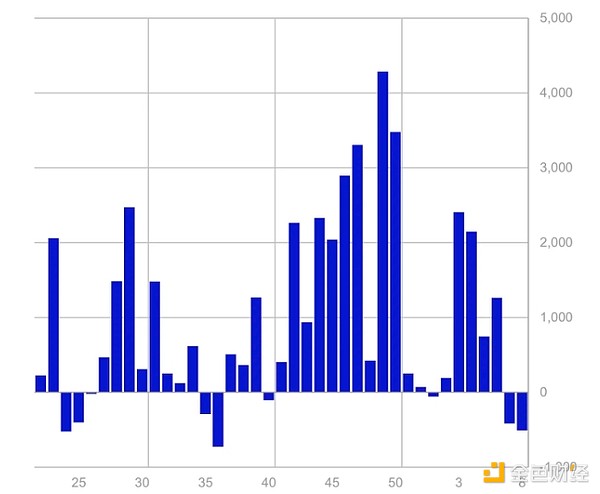
Capital flows in cryptocurrency investment products. Source: CoinShares
CoinShares research head James Butterfill attributed this to the uncertainty around trade tariffs, monetary policy, and inflation. He said:
"We believe investors are exercising caution in the wake of the presidential inauguration and the subsequent uncertainty around trade tariffs, inflation, and monetary policy."
At the same time, market participants are awaiting the final US inflation data of the week.
Key points to know:
The Personal Consumption Expenditures (PCE) index, the Fed's "preferred" inflation gauge, will be released on February 28.
Last week, initial jobless claims exceeded the median forecast by 4,000, reaching 219,000, indicating a weakening labor market condition.
This has significantly reduced the expectations of multiple rate cuts by 2025.
For example, according to the CME Group's FedWatch tool, the likelihood of rate cuts is low, even though two FOMC meetings are scheduled during this period.
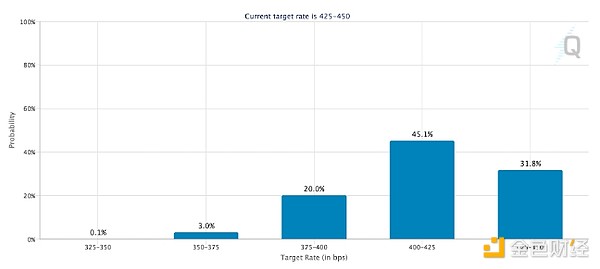
Probability of FOMC target rate on July 30. Source: CME
The probability of the Fed keeping rates unchanged at its next two meetings is currently 97.5% in March and 73% in May.
Crypto Market Faces Huge Upside Resistance
The decline in the total market capitalization of all cryptocurrencies today is part of the adjustment that began on January 31, with the key support area turning into resistance.
Key points:
The trading price of TOTAL is below the key supply area between $3.28 trillion and $3.31 trillion, which is the 50-day and 100-day simple moving averages (SMA).
The Relative Strength Index (RSI) is currently at 40, indicating that the market conditions are still favorable for a downward trend.
Furthermore, the sell-off could push the crypto market down to the $3.03 trillion support level.
Note that this has been the key support area for TOTAL since November 20.
A break below this level will trigger a sell-off, leading to a drop towards the 200-day SMA at $2.72 trillion.
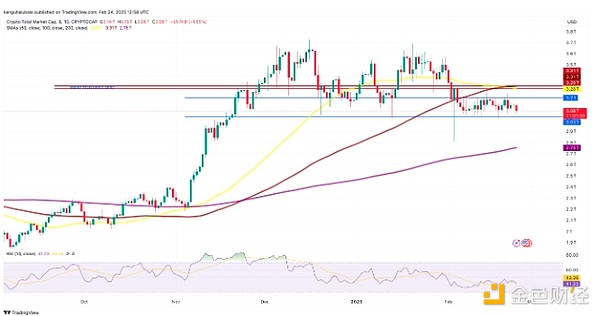
TOTAL/USD daily chart. Source: Cointelegraph/TradingView
Conversely, a push higher in the crypto market capitalization could bring it back to the $3.2 trillion level or higher, testing the aforementioned resistance.
According to the renowned analyst Crypto Zone, "the crypto market is in a neutral period" with the Fear and Greed Index at 40.
The analyst added: "This indicates that investors are cautiously weighing their actions, and this is a critical moment for strategic decision-making."
BTC Seen Dropping to $70,000
BitMEX co-founder Arthur Hayes stated on social media that many IBIT holders are hedge funds that are earning yields higher than short-term US Treasuries by going long on ETFs and short on CME futures. If BTC price drops and the basis (the difference between ETF price and futures price) narrows, these funds will sell IBIT and cover their CME futures positions. These funds are currently profitable, and considering the basis is close to US Treasury yields, they will unwind their positions during the US trading session to realize their profits. I see it dropping to $70,000.
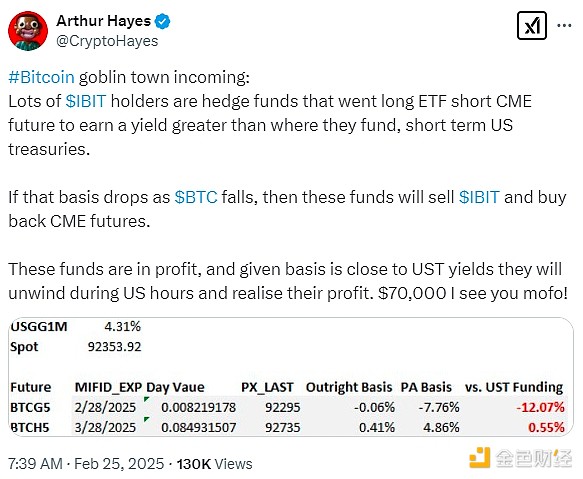
Quinn Thompson, the founder of the crypto hedge fund Lekker Capital that trades using macroeconomic data, posted on social media: "I'm trying to convey to those who may be complacent/in denial that $95,000 is still not a bad exit price relative to what I think we can trade in the next 6-12 months."
Thompson believes there is an 80% chance that BTC will not hit a new high in the next three months, and a 51% chance it will not hit a new high in the next 12 months.
Sources: Xinhua News, Sina Finance, Securities Times, Wall Street Journal, Coindesk, CoinTelegraph, Twitter, etc.







